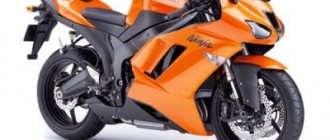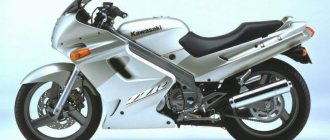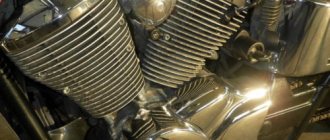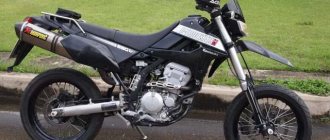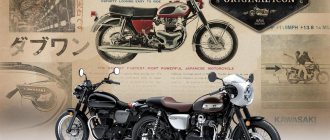The history of the Kawasaki W650 retro motorcycle began in 1999 and ended only in 2008 with the final discontinuation of the model. In the 60s of the last century, a similar motorcycle model with a similar name and design was produced, but these versions have nothing in common with each other.
The Kawasaki W650 was created for the domestic market of Japan and European countries, but during the first four years of mass production it was supplied to North America, where it was discontinued in 2004 due to low sales. A model with a smaller engine capacity was produced for the Japanese market - the Kawasaki W400.
The Kawasaki W650 motorcycle was equipped with a two-cylinder in-line engine with a capacity of 50 horsepower and a volume of 676 cubic centimeters with an air-cooling system. Compared to similar models of motor vehicles, the W650 stood out due to the presence of a kick starter and electric starter, chrome parts and hydraulic front disc brakes (drum mechanisms were installed at the rear."
The Kawasaki W650 model was finally discontinued in 2008. The motorcycle's successor, the Kawasaki W800, was released by the Japanese company only in 2010 and received an injection engine, but retained the classic design inherent in British motorcycles of the 1960s.
Engine
The engine installed on the Kawasaki W650 was practically no different in characteristics from the prototype: a two-cylinder in-line unit with an air cooling system and a camshaft drive passing through a rod and a helical bevel gear. The engineers decided to keep the mechanical starter, despite the fact that the design implied an electric one. The power system was equipped with the usual carburetors, however, equipped with a large number of electrical systems in order to comply with Euro-3 standards. The Kawasaki W650 engine was not particularly powerful, but could please with high thrust at medium and low speeds.
Russian motorcyclists, in their reviews of the Kawasaki W650, cited the need to adjust the valves after a mileage of more than 30 thousand kilometers as the main trouble associated with the engine. The difficulty lies in finding mechanics who can cope with the sophisticated design of the Japanese motorcycle engine. In other aspects, the power unit is reliable and unpretentious and can easily cover more than 100 thousand kilometers before its natural death.
Comfort
The bike will be convenient primarily for those who have been driving such equipment for a long time. Perhaps it will be comfortable for people who have never ridden a bike before. As for the rest, they are unlikely to be happy at first. And the point here is not in the model, but in the features of the class.
Judging by the reviews, those who once purchased a new motorcycle more often praise the seat upholstery, unlike those who bought the bike on the secondary market. However, this is not a problem, because you can easily replace the material with a new one. Otherwise, even a used car is comfortable if it has been properly cared for.
Spare parts are not difficult to buy secondhand. Maintenance usually does not take much time, because apart from consumables, you rarely have to change anything. So it won’t take much time to maintain the model, unless of course it will be standing in the open air.
Transmission
Rough operation of the gearbox, coupled with a quick search for neutral - all products of the Japanese company. The Kawasaki W650 could not escape this either: the technical characteristics and power of the engine do not allow the transmission to be properly loaded, as a result of which its service life is similar to the service life of the engine itself. Unfortunately, it is impossible to say the same about the clutch: at best, it will last 40-50 thousand kilometers, after which it will require replacement.
Special versions of Kawasaki KLR650
Along with the standard model, Kawasaki produces a number of special versions of the KLR650. The first is the Adventure version , equipped with the mentioned saddlebags, additional diode headlights, arches, a tank cover, as well as 12-volt and USB sockets. The Kawasaki KLR650 Adventure will be available in Cypher Camo Gray color scheme.
In addition to the Adventure, there is a Traveler model with a factory-installed center case, 12-volt power outlet and USB socket, in Pearl Lava Orange.
The standard version of the 2022 Kawasaki KLR650 will be available in Pearl Sand Khaki and Pearl Lava Orange color options. KLR650 ABS will only be available in Pearl Sand Khaki.
Frame design and body kit
Like any other classic motorcycle, the Kawasaki W650 is completely devoid of any body kit, which significantly reduces the owner’s recovery costs in the event of a fall or accident. However, there are also some nuances here: the motorcycle frame is completely authentic, which affects the handling of the motorcycle and makes it practically unsuitable for restoration in more or less serious accidents due to the complete loss of body geometry. Actually, when buying, you should first of all pay attention to the frame and inspect it in person, and not just from the photo of the Kawasaki W650.
What do the owners say?
Most people like the model, although some note that it is somewhat unbalanced. Perhaps this is a matter of subjective feelings. For example, a person drove a retro classic with a weaker engine.
And here the motorcycle is much more powerful, but its chassis is still the same retro classic. So it can sometimes feel uncomfortable at first.
Those who are just trying this class of technology are satisfied. Still, on the one hand, the model looks interesting, in an old-fashioned way, and on the other hand, it’s not so weak in terms of speed. In addition, many are happy with how much such a car costs.
The price for this equipment starts from 190 thousand Russian rubles. It's not that expensive, even for a used one.
Based on the description of the motorcycle by those who previously owned a sports bike, on this bike they seem to be relaxing after sports equipment. However, this can be said about all retro classics. After all, measuredness and slowness are inherent in all representatives of this category, no matter how powerful they may be within the class.
In conclusion, the Kawasaki W650 is an excellent example of a retro classic motorcycle. For lovers of genuine antiquity, such a bike, of course, will not be enough. As for those who want to try something old school, but still released relatively recently, this is a great choice.
Brake system
Drum-type rear brake mechanisms have one undeniable advantage - practically immortal linings, but they do not cope with their immediate task very well. It is quite difficult to catch the moment when the rear wheel is completely locked; a lot of effort is required to apply the rear brake lever.
The front disc brakes are strikingly different from the classics and have excellent information content, effectively slowing down the motorcycle. The service life of the front brake pads is quite decent - at least 15 thousand kilometers.
On road
So, let's move from theory to practice and ride the Kawasaki Versys 650. The first thing you notice when rolling out of the garage is the smooth ride. At low speeds, the bike quietly crawls forward, not trying to react sharply, like a sportbike, to the slightest touch of the gas handle. In this case, the acceleration with a sharp opening of the gas is enough to throw the rear wheel into a skid - be careful. The “evergreen” touring enduro has enough power to rival anyone on the road except sportbikes and particularly powerful classics. Accelerating to 100 km/h in 4.7 seconds, it is capable of reaching speeds of up to 190 km/h. Its modest-looking standard windshield copes well with headwinds up to 140 km/h, but tall riders, from 180 cm and above, will probably want to install a higher windshield - at least, that’s what most reviews say owners of Kawasaki Versus 650.
Pendants also evoke positive emotions. This, of course, is not a hard enduro, or even the legendary “Africa Twin” of the 90s, but the Kawasaki Versys 650 chassis confidently handles potholes and bumps. You can’t expect the comfort of the Honda GL1800, but in the city it seems that municipal services suddenly put their heads together and repaired all the roads at once. What else do you need? Also, perhaps, a comfortable fit, maneuverability, directional stability and the ability to customize the suspension to your parameters. On all points, the Kawasaki Versus 650 can be given a plus sign - everything is fine with it. And since 2015, the bike has also received a new fork and a 21-liter gas tank, with which you can safely go even to the Kola Peninsula (before restyling - 19 liters). The motorcycle's curb weight is just over 200 kg, and thanks to its not too high center of gravity, the Versys feels quite light.
Suspension
The telescopic fork installed at the front has a feature that is useful in our conditions: its oil seals are covered with protective corrugations, which increases their service life and prevents the ingress of dirt. Of course, there are no suspension adjustments - however, they are not required: the engineers of the Japanese concern managed to achieve a compromise between comfort and ride - the suspension works almost perfectly. The spring preload of the rear shock absorbers can be changed by owners. The springs themselves have a long service life.
Specifications
- The length of the motorcycle is 2190 millimeters.
- Width - 905 millimeters.
- Height - 1140 millimeters.
- The engine is an in-line, four-stroke, two-cylinder with a capacity of 50 horsepower.
- Five-speed transmission.
- Maximum speed is 166 km/h.
- The volume of the fuel tank is 15 liters.
- Acceleration dynamics - 5.4 seconds.
- Curb weight - 212 kilograms.
Model history
Serial production of the Kawasaki W650 was carried out from 1999 to 2008. The model was a remake of the W1 650 motorcycle, equipped with a 1967 engine. The prototype for the W1 650 model was the licensed copies of the BSA A7 - the Meguro K1/K2 motorcycles, produced by the first Japanese motorcycle manufacturer Meguro, which was absorbed by the Kawasaki concern in the 60s of the last century. Licenses for the assembly of the 500 cc model BSA A7 and its modified versions belonged to the Meguro company.
During the development of the new model, Kawasaki engineers modified the 650 Mizuro X, or A10, by modifying the engine, which made the model more convenient to control and dynamic. Over a ten-year period from 1965 to 1975, Kawasaki released three versions of the 650 cc model: W1, W2 and W3, gradually improving their characteristics and eliminating emerging malfunctions.
In order to replace the Zephyr line of motorcycles, Kawasaki decided in 1999 to re-release its own models with the W index, as a result, production of the W650 began, which was later succeeded by the W800. When developing the Kawasaki W650, engineers relied on all the experience of creating the classic W series, the British motorcycle Triumph Bonneville and other analogues. The new model was equipped with modern electronic equipment and an anti-vibration mechanism.
Simultaneously with the W650, the W400 model was produced: their production lasted until 2008, when new environmental standards were introduced and they ceased to comply with them. The company decided to launch an updated version of the model with an 865 cc engine, DOHC valve drive and fuel injection.
Accessories Kawasaki KLR650
Kawasaki KLR650
Owners of the Kawasaki KLR650 have ridden their motorcycles all over the world, and this requires certain equipment. For the new model, Kawasaki has prepared a whole range of accessories that make long journeys more convenient. The first and most obvious addition is a set of hard cases, side and center, which can accommodate a full-face helmet. All three cases can be opened with one key. In addition to these, the enlarged aluminum trunk allows you to attach additional luggage. Other accessories include warm handles, LED additional headlights, crash bars, a 12-volt outlet and a USB socket.
Owner reviews
Motorcyclists speak very flatteringly, first of all, about the classic retro design of the Kawasaki W650, noting that such an appearance attracts the attention not only of other motorcyclists on more modern bike models, but also of motorists. Despite the obvious agility and dynamism, the motorcycle can hardly be classified as racing or sports - it was created for style, but not for setting speed records. There is a possibility of increasing power, but motorcyclists' reviews say that there is no need for such tuning: the W650 is made in the spirit of the good old British classics, and no one wants to spoil it with excessive modifications.
Design of Kawasaki KLR650 2022
Kawasaki KLR650 2022
The Kawasaki KLR650 is difficult to confuse with anything else. There is a curved predatory beak of the front fender, a powerful silhouette, and a long single-level seat, under which the exhaust muffler is located. Despite the familiar features, the plastic has a new shape and now better protects the feet from water and wind. The new windshield is 5cm higher than the previous one and is adjustable using tools with a 3cm travel.
The Kawasaki KLR650's new bright LED headlight significantly improves visibility and uses less power, while longer mirror stems improve visibility of what's happening behind you. The digital instrument panel with white backlight and LCD display displays all the necessary information and is easy to read at a glance: there is a speedometer, odometer, two tripmeters, a fuel level scale, a clock and a turn signal indicator.
